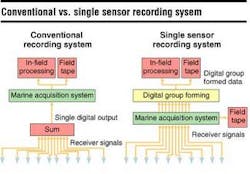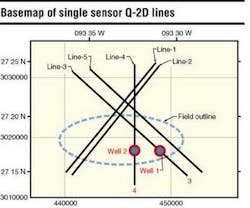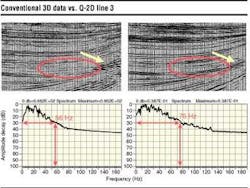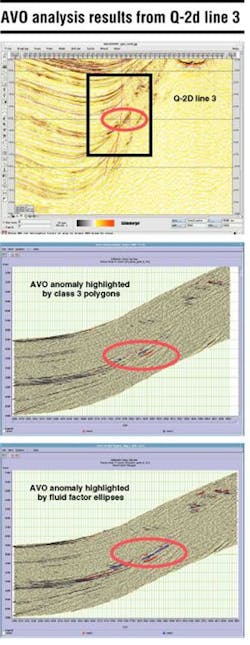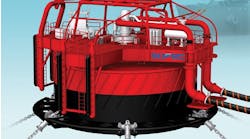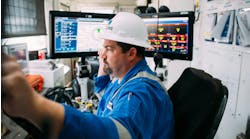By Jeff Gee-Shang Pan,Kerr-McGee Oil & Gas
Nick Modoveanu,WesternGeco
A recent study shows Q-technology can improve the signal-to-noise ratio, en-hance seismic resolution, and preserve amplitude accuracy of seismic data. This means Q-technology could help inter-preters produce more accurate reservoir charac-terization and field development.
The current method of acquiring towed streamer marine seismic data implies the deployment of 2D arrays of hydrophones distributed along the length of each streamer. The analog outputs of all hydrophones comprising each group are summed, yielding a hardwired array response. The 2D analog arrays are designed to provide spatial, anti-alias filtering of the seismic data and to attenuate the in-line, water-borne, and cross-flow induced noise. The group interval for the current streamers is typically 12.5-m or 25-m, and the array length is longer than the group interval.
The Q-towed streamer acquisition technology uses point-receiver recording with a 3.125-m interval between individual hydrophones. The output from each hydrophone is digitized and recorded separately on tape. For each hydro-phone, the sensitivity is measured and the calibration factors are provided for subsequent processing. The new system allows the recording of 4,000 channels per streamer, up to a maximum of 20 streamers.
In the summer of 2000, five 2D lines were acquired using the single-sensor towed marine acquisition system with a calibrated marine source. The lines were acquired over a recent deepwater discovery in the Gulf of Mexico. Previous 3D seismic data were acquired in the same area using a conventional streamer acquisition system. Two wells were drilled over this new field, and two lines were acquired to tie these wells. A study was then conducted to determine the benefits of the new acquisition system for improvements in signal-to-noise, seismic resolution and amplitude accuracy over the reservoir.
Acquisition, processing parameters
The acquisition parameters for the 3D data were typical of a non-exclusive proprietary survey. The processing parameters were based on a differential move-out (DMO) and post-stack migration processing flow. Although the Q-2D lines were acquired and processed with different parameters, the 3D data were extracted along the Q-2D lines with the same spatial and temporal sampling for comparison.
Coherent noise attenuation
The success of seismic processing methods for coherent noise attenuation depends on the proper spatial sampling of the seismic wavefield. Single-sensor streamers with a 3.125-m group interval allow adequate sampling of the swell noise and other types of noise traveling at very low apparent velocities along the cable. If the single sensor recorded at 3.125-m group interval is decimated at 12.5-m group interval, the swell noise is no longer coherent. The attenuation of the swell noise and other types of streamer-induced noise will be more difficult to suppress during the processing (Jenkerson, 2000).
The digital group forming (DGF) applied on single sensor data replaces the hydrophone array hardwired in the conventional streamers. The DGF process consists of the following steps:
• Apply perturbation corrections
• Apply a linear-adaptive, coherent noise attenuation filter (LACONA)
• Apply an anti-alias filter corresponding to the output group interval (12.5 m)
• Decimate the data to the output group interval (12.5 m).
As part of the perturbation corrections, scaling factors are applied to each hydrophone. This compensates for different hydrophone sensitivities. Also receiver static corrections, receiver motion corrections, and normal moveout corrections could be applied to the data prior to the application of any filtering process. This step contributed to more accurate amplitude preservation and improved frequency content of the seismic signal. A hydrophone array response corresponding to an 18.75-m hydrophone array length and 12.5-m output group was simulated from single-sensor data acquired with 3.125-m receiver interval. This was compared with the DGF output at 12.5-m group interval. Attenuation of the coherent noise on DGF data is better than that of a conventional hydrophone array.
Frequency bandwidth
The DGF process preserves the higher frequency content of the seismic data better than the conventional hydrophone arrays due to the perturbation corrections that are applied as part of the process. More coherent energy is preserved on DGF data.
Basemap of the five Q-2D single sensor lines. The schematic field outline is shown in the blue dashed line.
The deployment of single sensor streamers at a shallower depth is another factor that allows a better preservation of the high-frequency bandwidth. Towing the streamers at a shallower depth shifts the receiver ghost to a higher frequency. This improves the high-frequency bandwidth of the seismic signal.
The swell noise is the primary limiting factor for the depth at which the streamers can be deployed. The fact that the swell noise is more effectively attenuated by DGF process than conventional hydrophone arrays allows the single sensor streamers to be deployed at shallower depth. An examination of the amplitude spectra indicates that the average improvement in frequency bandwidth for single sensor data is 54% for shallow data (1,000-3,000 ms) and 27% for deep data (3,500-5,000 ms).
Spatial sampling
The small group interval of single sensor data allows better selection of spatial sampling rate that satisfies dips, velocities, and frequencies requirements. To illustrate the benefits of a finer sampling rate, single sensor data was processed through the same processing sequence as was applied on the DGF data. The bin size was 6.25-m and 1.5625-m for the DGF data and the single sensor data respectively. Small faults affecting the reservoir are visible on single sensor data due to the improved spatial sampling of the seismic wavefield.
Amplitude and AVO
The coherent noise attenuation enabled by single-sensor data, and the perturbation corrections applied, compensate for different factors that could affect the seismic signal. They contribute to an improved amplitude accuracy of single sensor data. Another element that contributes to better amplitude accuracy is the calibrated marine source (CMS). CMS removes the shot-to-shot source variations.
Conventional 3D data versus Q-2DLine 3 between 3,000 to 5,000 m. The 3D data shown here were extracted along the Q-2D Line 3 and resampled into the the same spatial and temporal sampling as the Q-2D line. The yellow arrows highlight target events.
The CMS system uses near-field hydrophones to record the acoustic output of each air gun in the array. From these, the far-field signature of the total array is derived (Ziolkowski et al, 1982) for every shot. Central frequencies of the amplitude spectra and root mean square (RMS) values are extracted from the source wavelets and displayed. The shot-to-shot signature variations can be removed if a deterministic designature operator derived for every shot is applied to shape the source wavelet to a desired zero-phase wavelet.
AVO analysis of the target events on Q-2D Line 3 confirmed Class 3 type of AVO anomaly, which was indicated by the AVO forward modeling using well 3.
To estimate the amplitude accuracy of single-sensor data, the stack traces of the pre-stack migrated DGF data were compared with the synthetic seismograms of wells 1 and 2, and the amplitude vs. offset (AVO) attributes derived from the DGF common depth point (CDP) gathers investigated. The Q-2D lines tie well with the well synthetics. The wavelets used to build the synthetics were extracted from the final processed data for Line 3 and Line 4.
AVO analysis was conducted on Line 3 starting from pre-stack time migrated gathers. The AVO attributes extracted from Line 3 confirmed a Class 3 type of AVO as indicated by the forward AVO modeling performed at Well 1. These results proved that the DGF data could be successfully used for AVO processing.
Conclusion
Although, for this study, a one-to-one comparison between single-sensor towed streamer data and conventional streamer data was not available, it was still possible to estimate the benefit of Q-technology in terms of coherent noise attenuation, frequency bandwidth, spatial resolution, amplitude accuracy and AVO applicability. The main conclusion of this study was, for this particular reservoir, that the Q-technology could improve the signal to noise ratio, enhance seismic resolution, and preserve amplitude accuracy of seismic data. As a result, the Q-technology could help interpreters produce more accurate reservoir characterization and field development.
Acknowledgments
The authors acknowledge Kerr-McGee Oil & Gas Co. and WesternGeco for the permission to present the results of this study.
References
Denham, L.R., 2000, The limits of seismic resolution: 70th Ann. Internat. Mtg., Soc. Expl. Geophys., Expanded Abstract, 2401-2404.
Martin, J., Ozbek, A., Combee, L., Lunde, N., Bittleston, S., and Kragh, E., 2000, Acquisition of marine point receiver seismic data with a towed streamer: 70th Ann. Internat. Mtg., Soc. Expl. Geophys., Expanded Abstracts, 37-40.
Jenkerson, M., Houck, R., Walsh, M., Combee, L., Curtis, A., Martin, J., Moldoveanu, N., Ozbek, A., Sayers, C., and Walker, R., 2000, Signal preserving swell noise attenuation using point receiver seismic data: 70th Ann. Internat. Mtg., Soc. Expl. Geophys., Expanded Abstracts, 2085-2087.
Ziolkowski, A., Parkes, G., Hatton, I., and Haughland, T., 1982, The signature of an air gun array Computation from near-field measurements including interactions: Geophysics, Vol. 47, 1413-1421.

